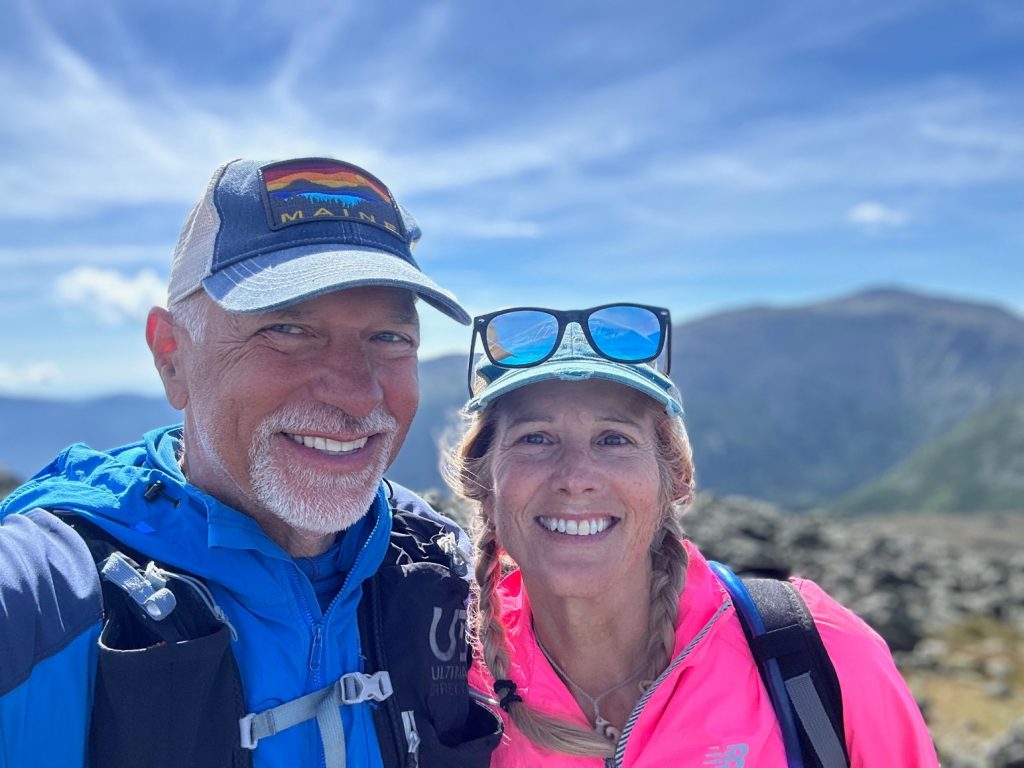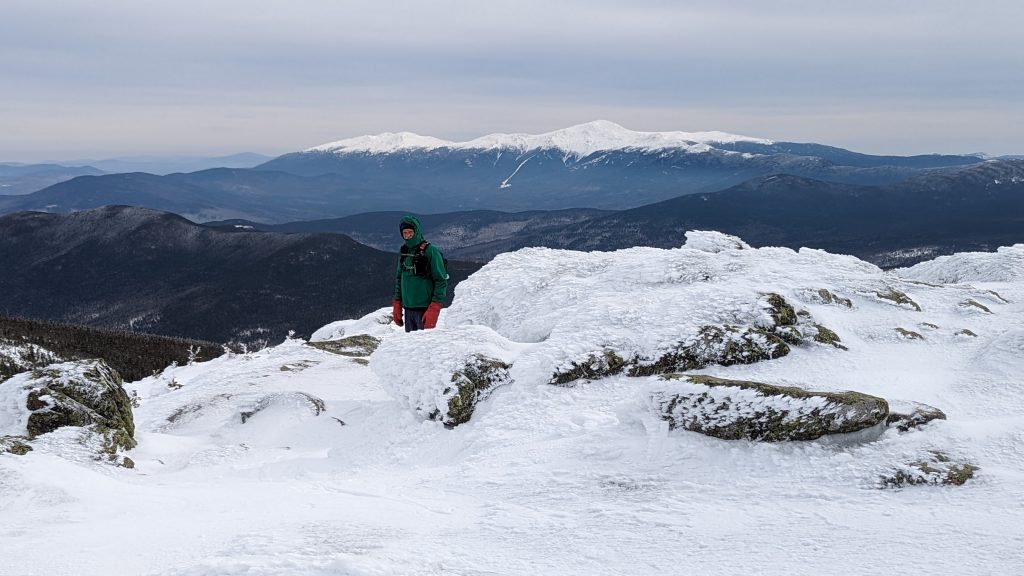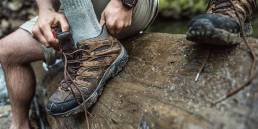We hunkered down behind some rocks at the summit of Mount Jefferson. The wind was chilly for mid-August, but the sun was still warm. Below us, a dozen hikers were hanging out on Monticello’s Lawn, a grassy area at the intersection of the Caps Ridge and Castle trails. A guy in shorts and a t-shirt was scrambling over the rocks at the summit nearby, talking to anybody who would listen.
“Wow, this is great,” he said. “This is my 48th! I finished my 48!” People on the lawn below cheered for him.
I smiled at my partner, John, and we congratulated the guy. Then I took the man’s phone and snapped some photos of him, beaming and with his arms held high, Mount Washington looming behind him.
It was my finish too, my last of the 48 4,000-foot peaks in New Hampshire, a quest I began some 16 years before when I climbed Pierce and Jackson with three of my then-preteen daughters. At the time, I thought it was ridiculous to jot the date down in the back pages of my White Mountain Guide because the list of 4,000-footers was long and I was in peak parenting mode, not peak bagging mode. There were soccer games and dance competitions to attend in 2007. I couldn’t imagine devoting time to the frivolous pursuit of hiking.

History of the 48 4,000-Footers
The idea of a list of 4,000-footers, and rules to govern their qualification (look up “prominence” to learn more) started in the 1930s, according to the Appalachian Mountain Club’s website. The list wasn’t refined and widely disseminated until the mid-1950s, when people had wider access to motor vehicles and more time off work. That’s when hiking took off, and the club has kept a list of finishers—as well as lists of other lists, such as those who finish all 48 in winter, or those who hike all 67 of New England’s 4,000-footers. Those who are interested can submit their completion dates for documentation and attend an annual dinner of the 4000 Footers Club held by the AMC each spring. They can also wear a patch designating them as members of the group, which in 2019 numbered over 14,000 (and 324 dogs!).
I never openly aspired to join that elite club. Over the years, I’d rediscover the White Mountains guidebook among my hiking and camping gear and jot down another date next to the name of a significant peak. I was hiking about one 4,000-footer a year. In 2014, I checked off the Bonds and Zealand while on an overnight with a big group, and the next year my sister-in-law and I climbed Franconia Ridge. The list of 48 was slowly whittling down but I still couldn’t envision the day that I’d fill in the last line on the list.
Hiking Madison and Adams alone in June 2019 was a big milestone. I made mistakes (forgot hiking socks, for one!), talked to myself a lot, got smoked by another female hiker, and could barely walk by the time I reached my car. But my kids were grown and I felt like hiking was something I could do—that I might actually finish that list of 48 someday. I had dates next to almost a dozen of the peaks by then, 12 years into my occasional quest for the 48.

Lessons Learned Finishing the NH 48
Since meeting my partner John about 15 months ago, the challenge to finish my 48 shifted into high gear. He’s an OG of the mountains who has almost completed the New England 67 Grid (that’s the 67 tallest in the region, summited in each month of the year, for over 800 total peaks) as well as other feats like the Colorado Trail and nearly all of that state’s 14,000-footers.
Together we hiked all last fall, winter, and spring, knocking off dozens of the mountains remaining on my list of 48 and then some. As of this writing, I’m a weekend away from finishing the New England 67 highest.
In the last year, hiking became more than a quest to check off the list in the back of the guidebook. It cemented our relationship, developed my outdoor skills, made me fall in love with winter again, and reminded me that I’m not too old to learn a few things.
One thing I learned was that it’s not always the right time to summit. In February, we attempted to climb Mount Jefferson via the Jewel and Gulfside trails. The wind was roaring up through the gulf between Mount Washington and Mount Clay, blowing us sideways, almost off our feet. Although the day was otherwise sunny and I was never uncomfortably cold, I couldn’t maintain the stamina needed to reach the peak. We were within sight of the top when I told John we had to turn around. I didn’t want to create a problem for myself or for him by pushing beyond my limits. The mountain would be there another day.
My layering game is totally on point now. Historically, I’d overdress or get blisters from doubling up socks, but there’s nothing like a ton of practice to iron out the wrinkles, and comfort is of primary importance. Now I wear multiple thin layers of techwick-type tops according to the outside temperature. When it’s cold, I’ll add an EMS Ascent full-zip hooded fleece under a solid insulated polypro vest—also EMS—for most hikes near or under 30 degrees. Keeping the same layers packed in my duffel makes hiking every weekend a breeze because the habit eliminates guesswork and decisions.
Nutrition on the trail has also been nailed down and simplified. There’s nothing like a frozen PB&J in the shelter of a rock on a summit to make me feel like a real hiker. But that’s not all I pack, because I’ve learned through trial and error that I need plenty of replenishing electrolytes as well as gels to ingest a steady supply of calories, starting in the first hour of any outing. Skipping snacks results in poor performance on my part (and might have spiked my first attempt on Jefferson last winter).
Proper footwear continues to be my obsession. I’ve blogged about trying to find the right running shoes for many years, and the quest continues with hikers. I have bunions that can be painful if my boots are ill-fitting, but I’ve finally settled (like Goldilocks) on a system of KT Tape and toe socks that alleviate much of that problem. Still, I have four pairs of hiking boots and shoes that provide varying levels of support and cushion, giving me plenty to fuss over before, during, and after each outing.

Rosy Memories
It took me a long time to understand John’s compulsion to hike every weekend, but I think I have the answer. It’s not about memories of individual events, like skiing down Sawyer River Road on rubbery legs after summiting Carrigain. It’s the addicting glory of witnessing the sun poking through the clouds on a summit, the feeling of accomplishment at the end, and the unspoken privilege of waking up and doing it again the next morning on sore legs and in wet boots because we can.
Even so, I have favorite memories of hiking the 48, like the overly friendly gray jays on the Hancocks, powerwalking the last few miles of the 14-mile roundtrip to Owl’s Head so we’d average two miles an hour; the bluest of blue skies above the snowy and challenging summit of Whiteface in winter, and the wild feather-shaped rime ice formations on the summit of Garfield on a freeze-your-nose January day.
August 12 was the day of my 48th, but it wasn’t my final mountain. We’re still hiking because it’s now our lifestyle, not just a short-term goal.
Alison O'Leary
Alison O’Leary is an avid cross country skier, author, and public speaker. See alisonoleary.com.
Related Posts
April 24, 2024
What to Bring When Road Tripping with Your Dog
Prepare for the ultimate road trip with…




